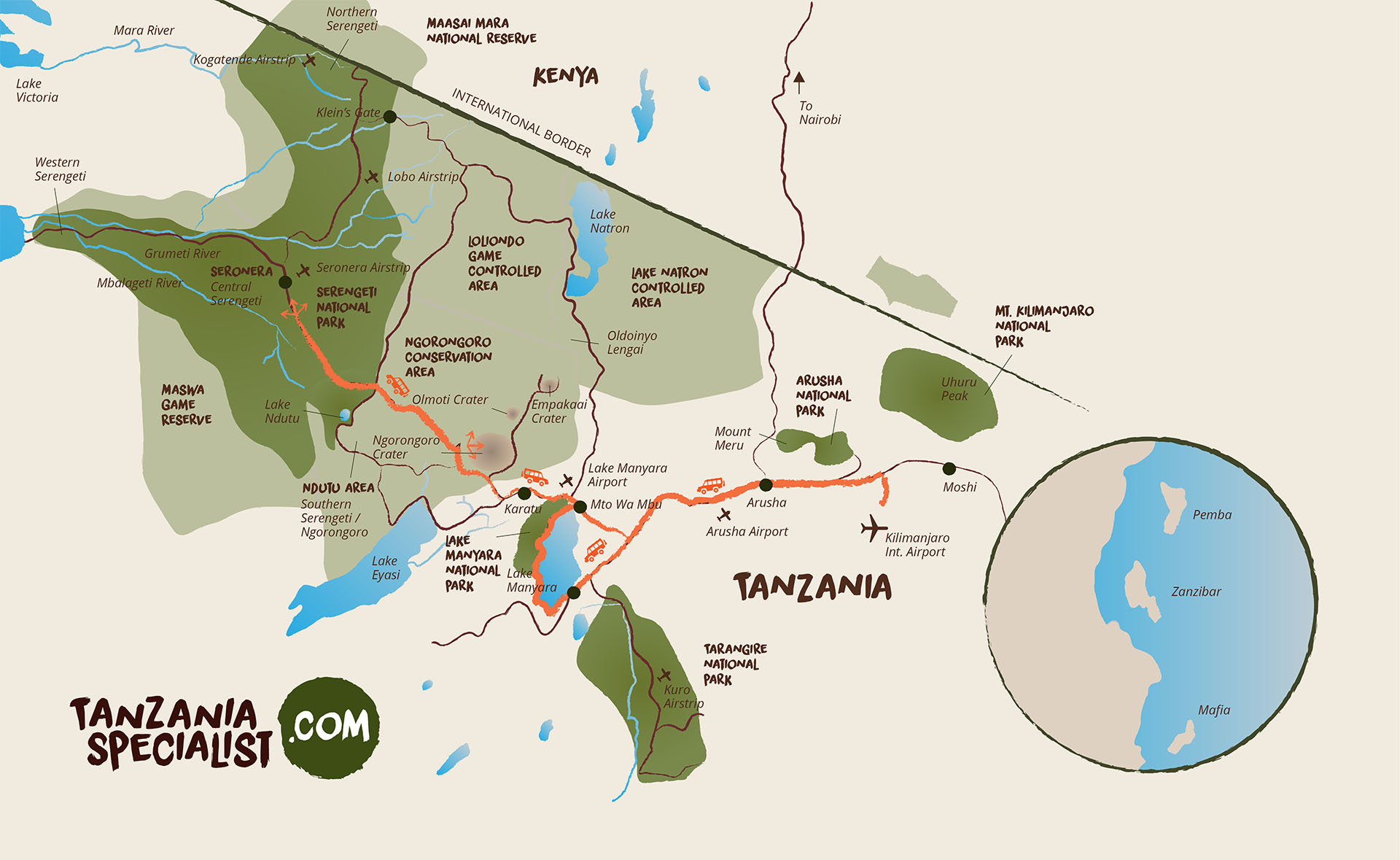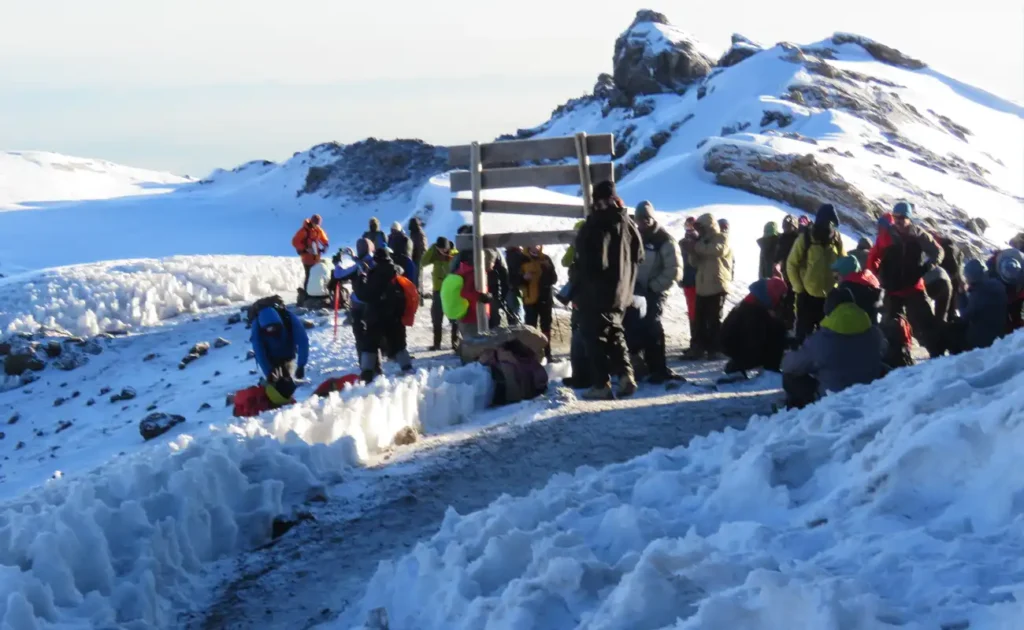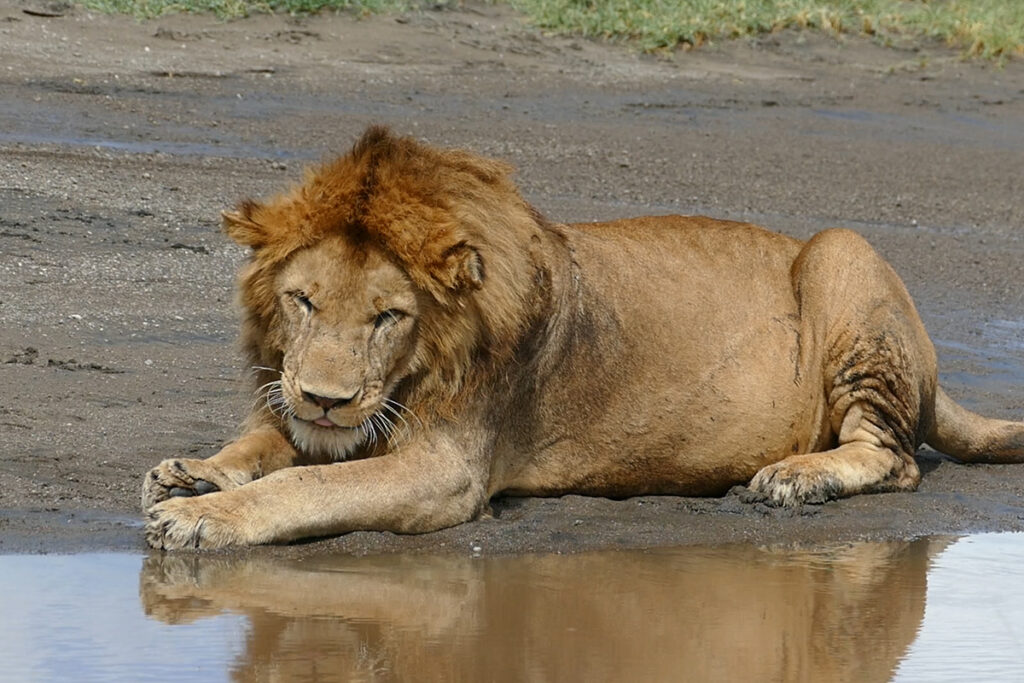Embarking on a 7-day Tanzania safari itinerary is more than just a wildlife adventure; it’s a deep dive into the pulsating heart of Africa’s natural wonders. Consider the fact that Tanzania is home to over 30% of Africa’s large mammal population, roaming freely in their pristine habitats. This journey offers an exciting blend of breathtaking landscapes and the rich diversity of life, each day bringing you closer to the rhythm of the wild.
The itinerary encompasses the iconic Serengeti National Park, famed for the Great Migration where over a million wildebeest and zebras traverse the sweeping plains. Add to that the historic Ngorongoro Crater, a UNESCO World Heritage site renowned for its dense population of wildlife, and you’re set for an unparalleled safari experience. Not to mention that a significant portion of Tanzania’s GDP is derived from tourism, emphasizing the pivotal role such safaris play in supporting local economies while offering unforgettable experiences.

Exploring the Basics of a 7-Day Tanzania Safari Itinerary
Starting your adventure with a 7-day Tanzania safari itinerary requires some basic planning. It’s essential to know where you will be traveling and what you want to see. A typical safari could include several stunning national parks, like the Serengeti or Ngorongoro Crater. These locations are teeming with wildlife, which makes them a prime destination for nature lovers. Planning helps ensure you maximize your experience and catch all the major highlights.
An important aspect of a successful safari is understanding the best times to visit. According to this article, the dry seasons are ideal because animals gather around water sources, making them easier to spot. Additionally, the weather is usually comfortable, with less chance of rain to disrupt your excursions. This careful timing allows for a more enjoyable and fruitful safari experience, as you witness nature at its finest.
Equally crucial is selecting the right accommodation to suit your comfort and budget. From luxury lodges to budget-friendly campsites, Tanzania offers a range of options. Based on this post, you can find a package that meets your needs without breaking the bank. Many safaris also offer the chance to engage with local communities, adding a cultural element to your adventure. This interaction enriches your trip and supports the local economy.
Lastly, don’t forget to pack wisely by including essentials like binoculars, a camera, and weather-appropriate clothing. You’ll want to capture every moment of your journey, from breathtaking sunrises to a lion’s roar at dawn. Besides, carrying a good guidebook will help you identify various wildlife species with ease. A well-prepared traveler is a happy traveler, ensuring a seamless and memorable safari experience. This approach helps in creating lasting memories of your African adventure.
Importance of Planning a Safari In Tanzania
Planning a safari in Tanzania is crucial to ensure you make the most of your adventure. This planning involves selecting the best routes and destinations to visit. By organizing your itinerary, you can optimize your time and see more wildlife within your stay. This proactive approach helps prevent any mishaps or surprises that could potentially derail your experience. A simple plan means more time enjoying the breathtaking beauty of Tanzania.
For a seamless trip, organizing your transport and accommodations before your arrival is essential. Tanzania offers a wide range of lodges and campsites, each providing unique experiences. Knowing where you’ll stay helps you avoid last-minute hustles and lets you relax and relish your journey. Besides, booking early can often result in cheaper rates. This financial foresight allows you to save money, which can be spent on other activities.
Additionally, educating yourself on the do’s and don’ts of safari etiquette enhances your experience. Simple practices like maintaining a safe distance from animals and minimizing noise make a significant difference. It not only ensures you remain respectful of the environment but also provides you with better animal sightings. List of etiquette tips can include:
- Maintain silence in vulnerable areas.
- Avoid feeding animals.
- Stay inside designated areas.
Ultimately, planning also helps you pack appropriately by considering the season and required gear. Whether it’s rain shoes or a sunhat, having the right attire can make your safari more comfortable. Checklists can be handy, reminding you of essentials like sunscreen, binoculars, and a camera. With the proper gear, you can capture memories and view wildlife in all its glory. Preparation is key to a rewarding Tanzanian safari experience.
Detailed Layout of an Optimized 7-Day Tanzania Safari Itinerary
An optimized 7-day Tanzania safari itinerary often begins with a day spent in the bustling city of Arusha. This city serves as the starting point for many safaris. It’s a great place to acclimate, gather any last-minute supplies, and enjoy some local culture. The next morning, you can head out to Tarangire National Park, known for its large elephant herds and baobab trees. A full day here allows for extensive wildlife viewing before heading to your accommodation for a restful night.
The third day can take you to the Serengeti National Park, one of Africa’s most famous safari destinations. Spend the next two days exploring the expansive plains. This is the perfect time to witness the Great Migration if you’re visiting during the right season. During these days, you’ll spot lions, leopards, and a plethora of other wildlife. This experience is often described as breathtaking and is the highlight of many Tanzanian safaris.
On day six, venture to the Ngorongoro Crater, a UNESCO World Heritage site. This area is a wildlife haven, with a high density of animals in a relatively small area. A day spent here can provide sightings of rhinos, Cape buffalos, and elephants. It’s an excellent spot for game drives and offers many photographic opportunities. The night is usually spent in a nearby lodge, providing a comfortable place to rest.
Conclude your safari on day seven with a visit to Lake Manyara National Park, known for its tree-climbing lions and flocks of flamingos. This park provides a beautiful backdrop of the Rift Valley and offers a different but equally exciting wildlife experience. A leisurely drive back to Arusha marks the end of your safari, allowing you to reflect on the diverse landscapes and incredible wildlife you’ve encountered. An organized itinerary like this ensures you cover major parks, maximizing your Tanzanian adventure.
Noteworthy Experiences and Highlights of a Tanzania Safari
One of the most exhilarating experiences on a Tanzania safari is witnessing the Great Migration. This natural phenomenon involves millions of wildebeest, zebras, and gazelles crossing the Serengeti in search of fresh grazing grounds. The sight of these animals moving en masse is awe-inspiring and offers countless photo opportunities. This event is considered one of the most spectacular wildlife shows on earth. Timing your safari around this migration can lead to unforgettable memories.
Another highlight is visiting the Ngorongoro Crater, a UNESCO World Heritage site. This volcanic caldera is home to an incredible density of wildlife, providing exceptional game viewing opportunities. You can expect to see large herds of wildebeest and zebras, lions, elephants, and even the rare black rhino. The crater also offers stunning landscapes with its lush greenery and diverse ecosystems. Spending a day here immerses you in one of the world’s most unique natural wonders.
Exploring Tarangire National Park offers unique experiences distinct from other parks. Known for its large elephant population and impressive baobab trees, the park provides fantastic wildlife viewing. During the dry season, animals flock to the Tarangire River, making the game viewing even more spectacular. Bird watchers also have the chance to spot over 500 bird species in the park.
A visit to Lake Manyara National Park offers a completely different experience. Famous for its tree-climbing lions and diverse birdlife, this park provides a rich variety of sights. Lake Manyara is often carpeted with pink flamingos, creating a stunning visual spectacle. The park is also home to hot springs and groundwater forests, adding to its diverse attractions. It’s the perfect spot for adventurous souls wanting to explore Tanzania’s varied ecosystems.
Engaging with local cultures is another cherished highlight of a Tanzania safari. Visiting Maasai villages allows you to learn about the traditions and lifestyle of this iconic tribe. Their bold red attire, intricate beadwork, and unique way of life offer a rich cultural experience. Such encounters broaden your understanding and appreciation of Tanzania beyond its wildlife. It adds a personal dimension to your safari, making it even more enriching and memorable.
Essential Tips and Recommendations for the Safari
When preparing for a safari, packing the right essentials can make all the difference in your adventure. Start with lightweight clothing in neutral colors to blend in with the environment and stay cool. Don’t forget a wide-brimmed hat and sunglasses to protect yourself from the sun. Binoculars and a quality camera are must-haves for capturing those distant animal sightings. Including these in your bag ensures you are well-prepared for any situation.
Timing your safari can significantly influence your experience. The dry season, which generally runs from June to October, is often the best time to visit. During these months, animals gather around waterholes, making them easier to spot. Besides, the weather is cooler, adding to a more pleasant game drive. Planning your trip during this time can enhance your wildlife viewing opportunities.
Choosing the right guide is key to a successful safari. An experienced guide will provide insights into animal behavior and help spot wildlife you might have missed on your own. They also ensure your safety and help navigate the parks effectively. Guides can share fascinating stories and facts about the places you visit, enriching your overall safari experience. It’s wise to choose a reputable safari company known for its skilled guides.
Understanding safari etiquette is important for respecting both the environment and fellow travelers. Avoid loud noises to prevent scaring away the animals. Always follow the guide’s instructions and keep a safe distance from wildlife. Respecting these simple rules helps preserve the natural habitat and ensures everyone’s safety. Practicing good etiquette is a way to show appreciation for the incredible wildlife you’re privileged to observe.
Finally, don’t forget to immerse yourself in the local culture while on safari. Interacting with local communities provides a deeper understanding of Tanzania’s rich heritage. Visiting cultural sites and participating in traditional activities can offer unique insights. This is not only enriching for you but also supports local economies and fosters sustainable tourism. Embracing these opportunities makes your safari more meaningful and memorable.
Sustainability Practices to Follow for a Responsible Safari Experience
Embarking on a safari comes with the responsibility of protecting the environment and ensuring the well-being of wildlife. One effective way to promote sustainability is by choosing eco-friendly accommodations. These places often use solar power, recycle waste, and support local conservation efforts. Staying at such establishments helps reduce your environmental impact. It also shows support for businesses committed to preserving the natural beauty of the region.
Supporting local communities during your safari is another crucial aspect of responsible travel. Engaging with community-based tourism initiatives means your visit has a positive impact, providing economic benefits to local residents. Buying handmade crafts or participating in cultural activities can contribute to this goal. Respect and consideration for local customs enhance your travel experience. This interaction fosters mutual understanding and appreciation.
A vital practice on safari is minimizing waste and leaving no trace. Avoid using single-use plastics by carrying reusable water bottles and bags. Properly dispose of any waste to keep the environment pristine and safe for wildlife. These simple actions collectively contribute to a cleaner, healthier environment. They also align with the ethos of sustainable travel and responsible tourism.
When observing animals in their natural habitats, it’s important to keep a respectful distance. Disturbing wildlife by getting too close can have negative effects on their behavior and well-being. Always follow the guidance of your safari leader, who knows how to navigate without causing harm. Such practices ensure the animals’ environment remains undisturbed. This approach allows future visitors to enjoy these natural wonders, too.
Contributing to conservation projects can amplify the positive impact of your trip. Many safari operators work with organizations dedicated to preserving Tanzania’s wildlife and ecosystems. Participating in these projects or donating helps protect endangered species and habitats. Support for these efforts helps maintain the natural balance of the region. It’s an investment in the future, ensuring that these stunning landscapes remain vibrant for generations to come.

Frequently Asked Questions
A Tanzania safari offers unique experiences, from breathtaking landscapes to diverse wildlife sightings. Here are some common questions and answers about planning your adventure.
1. What is the best time to go on a safari in Tanzania?
The best time to go on a safari in Tanzania is during the dry season, from June to October. During these months, animals gather around waterholes, making it easier to spot them.
The weather is also more comfortable as there is less rain, ensuring better road conditions. This period coincides with the Great Migration, offering a chance to witness one of nature’s most spectacular events.
2. How can I prepare for a Tanzania safari?
Preparing for a Tanzania safari involves packing appropriate clothing, such as lightweight, neutral-colored outfits. Essential items include a wide-brimmed hat, sunglasses, and sturdy walking shoes.
Don’t forget to bring a good quality camera and binoculars to capture the amazing wildlife. Booking accommodations in advance and obtaining necessary vaccinations are also important steps in preparing.
3. What types of wildlife can I expect to see?
On a Tanzania safari, you can expect to see a wide variety of wildlife, including the Big Five: lions, elephants, rhinos, leopards, and buffalos. You will also have the opportunity to see giraffes, zebras, wildebeests, and various antelope species.
Birdwatchers will be delighted to find over 1,000 species of birds in Tanzania. From the majestic African fish eagle to colorful lilac-breasted rollers, the diversity is astounding.
4. Are there any safety concerns while on a safari?
Safety is a top priority while on a safari, and precautions are taken to ensure a secure experience. Always follow your guide’s instructions, maintain a safe distance from animals, and remain in your vehicle during game drives.
It is also advisable to use insect repellent to protect against mosquito bites and stay hydrated by drinking plenty of water. Choosing reputable tour operators who prioritize safety further minimizes risks.
5. What should I expect in terms of accommodation and amenities?
Accommodations on a Tanzania safari range from luxury lodges to budget-friendly campsites, offering various amenities. Luxury lodges often provide comfortable rooms, delicious meals, and additional services like guided walks or spa treatments.
Budget-friendly options might include tented camps with basic facilities such as communal dining areas and shared bathrooms. Both types of accommodations offer a close connection to nature, ensuring an authentic safari experience.



